
We are celebrating 15 years — and counting — of stories that are deeply researched and deeply felt, that build a historical record of what the city has been.
We are celebrating 15 years — and counting — of stories that are deeply researched and deeply felt, that build a historical record of what the city has been.
The Weeksville Heritage Center testifies to a long forgotten chapter in Brooklyn’s history. For the past ten years, visitors have been able to experience the physical vestiges — three restored houses and gardens — of a free and intentional 19th century African American community, hidden by successive waves of 20th century development. Earlier this year, WHC inaugurated a new era with the opening of a new building on this campus, designed by Caples Jefferson Architects, that boldly announces that this “multidimensional museum” is as firmly committed to its neighborhood’s present and future as it is to recovering and interpreting its legacy for contemporary audiences.
On the occasion of a landmark new exhibition, Funk, God, Jazz, and Medicine: Black Radical Brooklyn, presented by WHC in partnership with Creative Time, Jonathan Tarleton explores how Weeksville’s institutional trajectory has navigated the challenges of historic preservation, the pressures of real estate speculation, the complexities of art and culture acting as community catalysts, and the hopes and fears surrounding shifting neighborhood dynamics. In so doing, he offers a nuanced take of how this cultural institution has chosen to identify and celebrate local assets in the midst of a city that never stops changing. –C.S.
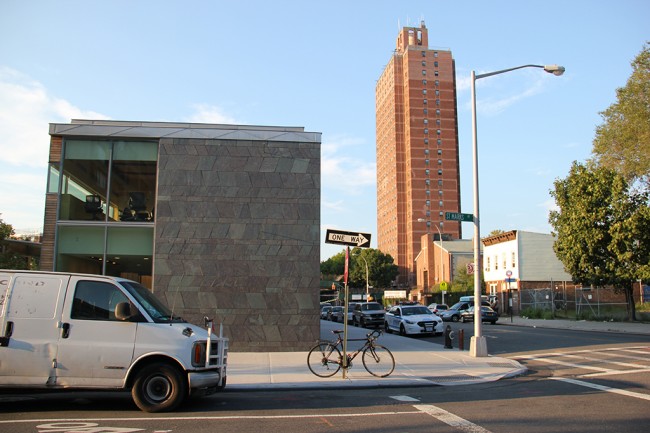
The intersection of St. Marks Avenue and Buffalo Avenue in Crown Heights with the Weeksville Heritage Center’s new building to the left and the Kingsborough Houses senior building to the right | Photo by Jonathan Tarleton
Mention of Crown Heights, Brooklyn, evokes a range of associations in contemporary New York City. The pulsating energy of the West Indian Day Parade, wending its way down Eastern Parkway each September; the beehive quality of Lubavitcher Hasidim headquarters straddling Kingston Avenue along its route. Often eclipsing such images of vitality, however, is the neighborhood’s well-broadcast history of racial tension and violence, most strikingly exhibited in the riots that pitted the predominantly black community against their Jewish neighbors in 1991. More recently, the neighborhood has joined the ranks of Bedford-Stuyvesant, Prospect Heights, Clinton Hill, and Fort Greene: another section of Brownstone Brooklyn grappling with the social and economic turbulence that has arrived with real estate speculation and a concurrent rise in housing prices. And while the rapidity of this shift and predatory practices of some speculators are undeniable, this overbearing narrative obscures and homogenizes what is an uneven contemporary experience across the neighborhood and further buries a deeper, richer history.
As you head east in the neighborhood, the new, increasingly young, white residents that most readily show how the face of Crown Heights is changing become fewer and fewer. Northeast Crown Heights is not yet glossy or trendy. The avenue names chart a journey north and west from the city — Brooklyn, Kingston, Albany, Troy, Schenectady, Utica, Rochester, Buffalo — and the area is far more reminiscent of the largely stagnant economies of those streets’ namesake cities than of Brooklyn’s well-publicized revival. Sturdy row houses first shrink by a story, then give way to vinyl-sided residences interrupted by non-descript industrial sites and a high concentration of towers-in-the-park public housing.
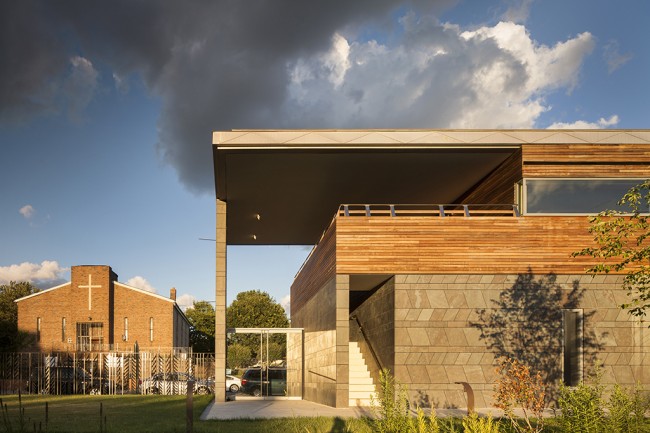
The new Weeksville Heritage Center building, designed by Caples Jefferson Architects | Photo by Nic Lehoux, courtesy of Caples Jefferson Architects
The western side of Buffalo Avenue in between Bergen and St. Marks is different. There, you look on to the new cultural arts building of the Weeksville Heritage Center (WHC), a multifaceted museum dedicated to preserving the history of a 19th century African-American community that spread across contemporary Crown Heights and Bed-Stuy. (The historic boundaries of Weeksville are Fulton Street on the north, East New York Avenue on the south, Ralph Avenue on the east, and Troy Avenue on the west.)
The new center is radiant: “unabashedly contemporary in its architectural expression,” according to Sara Caples, one of the building’s designers and principal of Caples Jefferson Architects; it maintains a modest scale but a high profile. Its wood, slate, and glass façade, punctuated by a woven metal gate at its main entrance, is a presentation of textures, patterns, and materials formerly foreign to the area, but harking back to the African roots of many of its residents. Most notably, it perfectly performs its aim of pointing the viewer elsewhere despite its beauty. The new L-shaped building hugs the southern street corner with a glass entryway, drawing the eye through the structure and diagonally across the interior of the block to a group of modest, wooden structures just beyond.
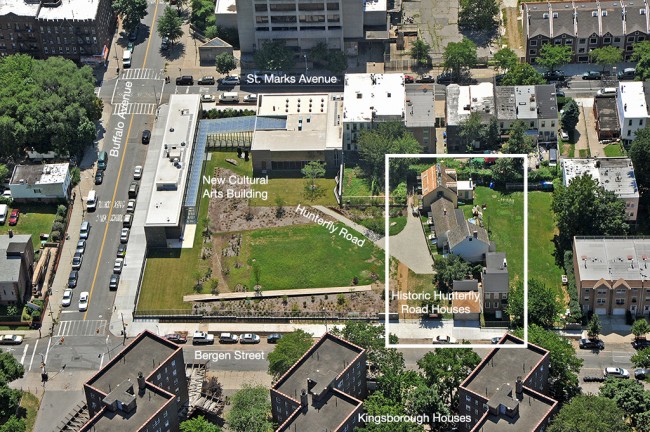
Aerial image of the Weeksville Heritage Center site | Photo by Julian Olivas, courtesy of Caples Jefferson Architects
A History of Self-Determination
This group of historic houses is the main attraction. They are all that remain of Weeksville, a freedman’s town founded by stevedore and black suffragist leader James Weeks and a group of black investors in 1838. The timing is crucial: just eleven years after the abolition of slavery in New York State and 27 years before the 13th Amendment formally abolished slavery across the United States. With landowning a prerequisite for men to gain citizenship and the vote, the town’s founding epitomized the black struggle for self-determination, and it pioneered a model for developing free, self-sufficient black communities in an era hostile to the proposition.
The small agricultural town thrived. It was home to 700 families, the Freedman’s Torchlight, one of the nation’s first African-American newspapers, and a number of community institutions. The schools, churches, and social organizations of Weeksville fostered movements for racial equality and nurtured individual leaders, among them Susan Smith McKinney Steward, one of the first black female doctors in the country. What was a haven for its residents also became a sanctuary for black New Yorkers fleeing the Draft Riots that took place in Manhattan in 1863, in which disgruntled whites made up primarily of Irish immigrants protesting the Civil War draft took out their anger on the black community and its supporters in one of the largest civil insurrections in US history.

Hunterfly Road Historic Houses | Photo by Jonathan Tarleton
The erosion of Weeksville’s unique history and sovereignty began as a growing Brooklyn engulfed its bucolic landscape. Farmlands gave way to housing, and street grids were re-positioned. New transportation infrastructure in Crown Heights brought waves of dense residential development: in anticipation of the 1883 opening of the Brooklyn Bridge, speculatively built row houses came to the area; the opening of the Kings County Elevated Railway in 1888 led to the development of hundreds of homes by 1893; and elevator apartment buildings arrived with the opening of a subway line along Eastern Parkway in 1920. Crown Heights’ fine architecture would help make it one of the most desirable residential neighborhoods in Brooklyn at the turn of the century, and more than 100 years later would lead to various historic district and landmark designations.
By the 1950s, Weeksville as a distinct place was forgotten, its built representations erased in part by 1940s urban renewal plans that brought the New York City Housing Authority’s Kingsborough Houses to the area, just north of where the new cultural center now stands. But the allure of Weeksville persisted: in 1968, historian James Hurley began studying the town and set out with community member and pilot Joseph Haynes in a small plane to see if they could spot any remnants. Off an alley, nestled behind newer developments at a suspicious angle to the street grid, sat four wood-frame homes. Further research confirmed that they were originals from Weeksville’s past that bordered what was once an old Native American trail called Hunterfly Road.
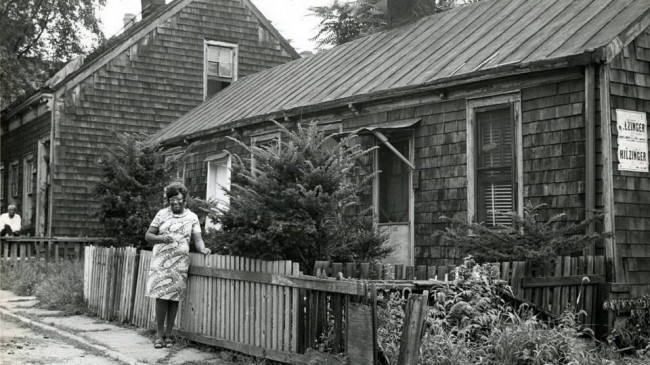
Hunterfly Road Houses, 1969, 5th of July Resource Center for Self Determination & Freedom | Photo courtesy of Weeksville Heritage Center
A new struggle to preserve the vestiges of the community began. Local activist and artist Joan Maynard — part of a long history of pioneering black women to come from Weeksville or lead its preservation — spearheaded the effort to landmark and restore the Hunterfly Road Historic Houses. Students from nearby PS 243, a direct descendant of Weeksville’s school that would later be renamed to honor that history, took part in archeological digs on site — shackles were among their discoveries — and successfully presented the case for the Hunterfly houses’ landmark designation before the City’s Landmarks Commission.
Bit by bit, funds were raised for repairs and restoration. Roofs were replaced, and one house was restored into a museum. The society formed to preserve Weeksville’s history, the precursor to the Weeksville Heritage Center, persevered despite ongoing challenges: one house burned down after a break-in and was rebuilt, another was the unfortunate punctuation mark for a car crash. In 2005, the three remaining original homes opened to the public, each restored to illustrate a period in Weeksville’s 150-year history.
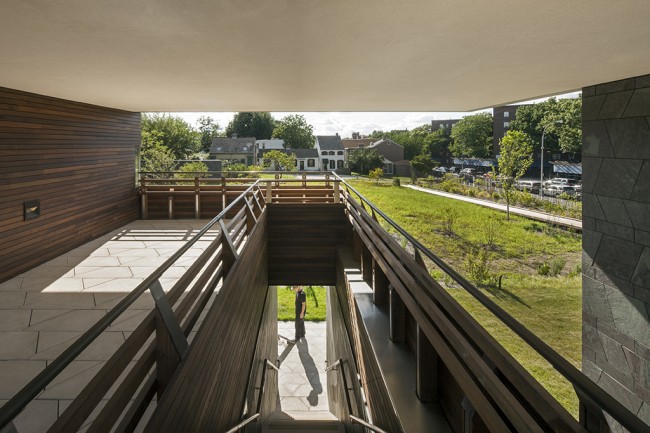
Looking from the second floor patio of the new Weeksville Heritage Center building to the Hunterfly Road Historic Houses| Photo by Nic Lehoux, courtesy of Caples Jefferson Architects
A New Era
For almost ten years, visitors to the Weeksville Heritage Center have taken in the history of the neighborhood through house tours that animate this free black community’s evolution from agricultural town to urbanizing neighborhood. With a new cultural arts center, new leadership, and the rapidly changing context of Crown Heights, WHC Executive Director Tia Powell Harris says “It can’t be denied: this is a new era.” But the era’s coming out party has roots two years back, when public art juggernaut Creative Time, most recently the organizers of Kara Walker’s momentous sugar sphinx at the Domino Sugar factory in Williamsburg, approached WHC about partnering for a project on how race is inscribed in the fabric of cities.
Saturday, September 20th marked the opening of the result: Funk, God, Jazz, and Medicine: Black Radical Brooklyn, a “walkable month-long art exhibition of four community-based art commissions” that interprets contemporary Crown Heights and Bed-Stuy through the lens of Weeksville’s tradition of self-determination. The process of pairing four commissioned artists — Xenobia Bailey, Bradford Young, Otabenga Jones & Associates, and Simone Leigh — with community-based institutions, all within eight blocks of Weeksville, sounds more like a progressive community development plan than a series of art installations. Rylee Eterginoso, a Black Radical Brooklyn curator and public programs coordinator at WHC, explained the exhibition’s beginnings in a mapping exercise to identify existing assets and “assume value in what is here.” Four of those assets became the project’s community partners: Boys & Girls High School, Bethel Tabernacle AME Church, Central Brooklyn Jazz Consortium, and Stuyvesant Mansion — once called home by Josephine English, the first African-American female OB/GYN in New York state.
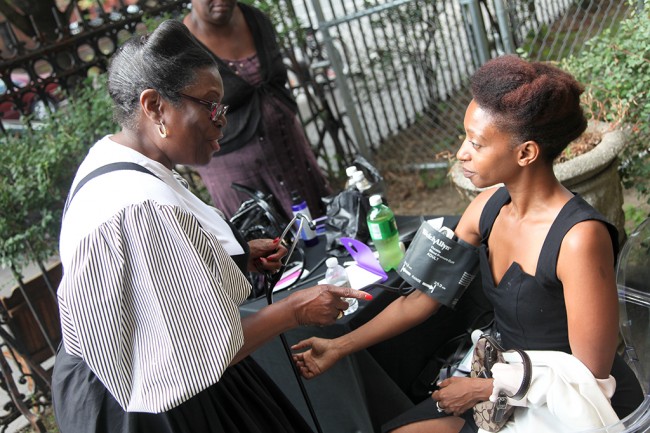
Free People’s Medical Clinic, installation by Simone Leigh in collaboration with Stuyvesant Mansion | Photo by Shulamit Seidler-Feller, courtesy of Creative Time
What this project looks like in practice is uniquely vibrant, the installations in aggregate representing the community’s contemporary and historical strength and challenging their viewers with forthright and timely questions of race and place. Curator Rashida Bumbray speaks about her approach to the installations the same way she does of the history from which they draw inspiration: “We need to make sure we don’t make history only nostalgia, … only beautiful, … when it was really radical and raw.” To that end, installation and performance artist Simone Leigh has transformed Stuyvesant Mansion into the Free People’s Medical Clinic, a legitimate and seriously administered care center that doubles as an art installation to pay tribute to a long and often unsung history of black doctors, nurses, and healthcare providers. Leigh drew specific inspiration from the Black Panther Party (whose groundbreaking provision of community health care in the late 1960s is referenced in the work’s title), Weeksville’s own Susan Smith McKinney Steward, Josephine English, and the United Order of Tents, a national secret society of black nurses started during the Civil War whose local base is blocks away.
In addition to OB/GYN care, acupuncture, massage, diabetes workshops, HIV testing, herbal instruction, Affordable Care Act guidance, yoga classes, and blood pressure screening provided by Brooklyn professionals, the space hosts a sound installation drawn from oral histories of black nurses; a waiting room magazine filled with fiction, poetry, and non-fiction pieces on medicine, secret-keeping, ghosts, and herbalism; and folk dance instruction. While the piece draws from Leigh’s consistent subject of black women and what has traditionally been considered “women’s work,” the scale and medium is new for her. The provision of real care in the Clinic is powerful and in many ways unsettling: the division between what is political, personal, and artistic is heavily eroded through the participation of visitors. Getting tested for HIV, as I did at the Clinic, becomes not just a personal choice, but something performed, and somehow more empowering. For Leigh, the process of creating the installation is even more instructive. Just getting to this point demanded that she confront a litigious medical climate that makes the provision of free, community-based health care particularly difficult.
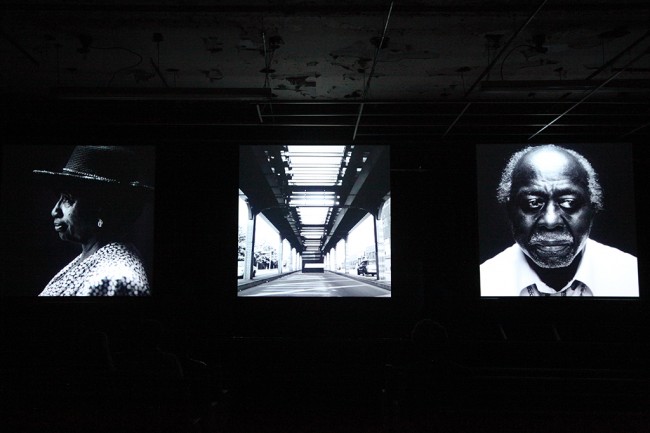
Bynum Cutler, installation by Bradford Young in collaboration with Bethel Tabernacle AME Church | Photo by Shulamit Seidler-Feller, courtesy of Creative Time
In the old PS 83 building — which once served as the sanctuary for partner Bethel Tabernacle AME Church — director and cinematographer Bradford Young has created a three-channel video installation that weaves together stationary shots of the church, the faces of its longest serving members, the steetscape of nearby Atlantic Avenue, and Weeksville’s historic houses. The atmosphere of the old sanctuary — with its fallen lights, peeling paint, and pews — sets up a meditative study of different sites, faces, and details. A reverberating score adds gravity to what comes across as a work with a profound respect for ancestry.
Artist and designer Xenobia Bailey and students from Boys & Girls High School have outfitted one of the Hunterfly houses with Funk-inspired furniture made of recycled materials, emphasizing the ability to create beauty out of objects of supposedly little value. Bailey, according to curator Rashida Bumbray, specifically sought to work with students from a poorly rated school. By using a hands-on creative process tied to both place and African-American history, Bailey’s work encompasses both the objects on display and her sustained engagement and exchange with local youth. The installation’s imagined narrative of a contemporary designer couple living in Bed-Stuy who make this furniture further brings out visions of entrepreneurship, self-sustainability, and community embedded in the making of the objects and the objects themselves.
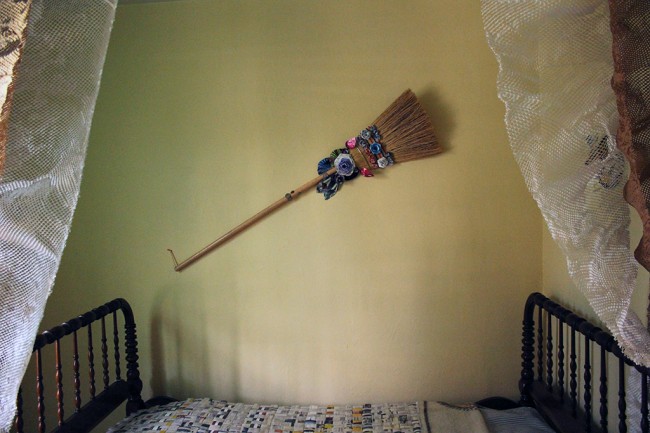
Century 21: Bed-Stuy Rhapsody in Design: A Reconstruction Urban Remix in the Aesthetic of Funk, installation by Xenobia Bailey in collaboration with Boys & Girls High School | Photo by Jonathan Tarleton
And on the street at one entrance to the neighborhood — the A/C Utica Avenue subway station — Otabenga Jones & Associates have created a temporary radio station in the back of a pink Cadillac with the Central Brooklyn Jazz Consortium. OBJK FM can be heard blaring in the plaza, online, and on WBAI 99.5 FM. The content ranges from oral history interviews; tributes to The East, a legendary Bed-Stuy music club and hub of black nationalism in the late 1960s and ‘70s; live interviews with community organizers and socially engaged artists; and a wide variety of live sets and recorded music. The messages found in the station’s content and the occupation of this public crossroads arguably make the radio station the most overtly political installation in the series. It’s also the least controlled, and it invites the community to use the stage of the Cadillac as a platform for their work and visions of community.
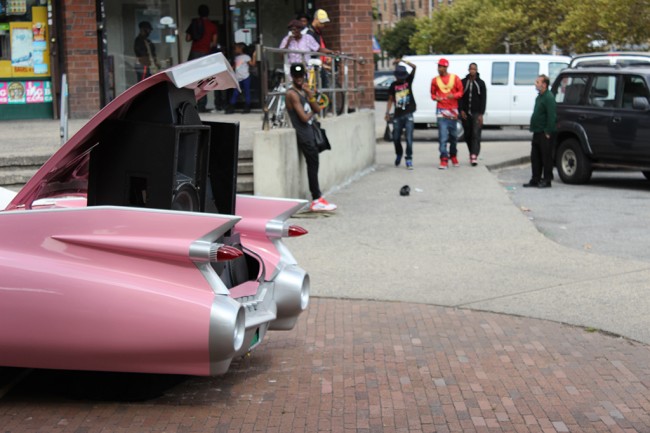
OJBK FM Radio, installation by Otabenga Jones & Associates in collaboration with Central Brooklyn Jazz Consortium at the intersection of Fulton Street and Malcom X Boulevard | Photo by Jonathan Tarleton
Community Attraction
The energy palpable at the exhibition’s opening party signals how popular Black Radical Brooklyn is likely to be. For curator Rashida Bumbray, the attention is “a bit of a double-edged sword.” Crown Heights’ new notoriety as a center of gentrification — it had the city’s highest rate of rent increase over the last year at 25.2% — is implicit in the exhibition’s preoccupation with struggles over land and self-determination. Bumbray and Eterginoso spoke of the intentionality of the curatorial team in addressing such issues head on. They are aiming to prioritize community members’ experience over visitors’ through private previews and community events spread by word of mouth. Instead of being only venues or sources, the community partners and their members collaborated with the artists. For Eterginoso, the exhibition isn’t successful without community buy-in and “entry point[s] for friends, families, and neighbors” to get involved.
In addition to the emphasis on local participation, Black Radical Brooklyn is intended to celebrate the contemporary neighborhood and its existing assets. This focus distinguishes the project from other attempts to link artistic practice to community development efforts. Some critiques of the current vogue of “creative placemaking” argue that such projects seek to use art brought in from outside to draw visitors into a community, thus making it desirable for new residents. But as Eterginoso quips, “This ain’t your grandma’s placemaking.” She continues, “Weeksville was a place that was made by James Weeks and a group of black investors. This is already a creative place. … We’re kind of screaming that.” Rather than fall in with the common and frequently misplaced narrative of arts and culture groups as drivers of gentrification, Weeksville Heritage Center and Creative Time join a growing number of institutions concerned with balancing investment with awareness about the threat of displacement.
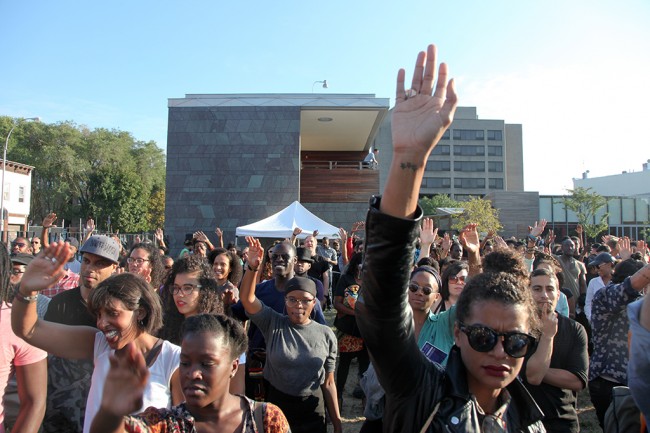
Funk, God, Jazz, and Medicine: Black Radical Brooklyn opening party | Photo by Shulamit Seidler-Feller for Creative Time
Eterginoso would consider the exhibition a success if it means more people know about Weeksville’s history and acknowledge it as integral to contemporary New York City. “That knowledge is power — who were you before you knew that Weeksville exists, and who are you after?” And as WHC executive director Tia Powell Harris puts it, “you can’t preserve history without some level of activism… Look at it this way: Weeksville was lost once, … and in an activist, defiant, determined way, we have to make sure that this very particular history of a very particular people … isn’t lost again. … Everybody’s welcome here, but you don’t get to take this over; you have to honor it and the concepts that it represents.”
The Relevance of History
The interpretation — and animation — of history that Black Radical Brooklyn provides is just one step in a larger goal of transforming the Weeksville Heritage Center from a museum preserving a history of activism into a larger, forward-looking institution that leverages its historic underpinnings to take on community issues. “Our mission is to celebrate this 19th century community and extract from it the qualities that we can now apply to today’s world,” says Harris. “We have to find practical ways to serve the community; otherwise, we are dispensable.” For her, this means empowering residents through arts programming sourced from and reflecting the community, providing skills classes for youth, revamping Weeksville’s historical house tours to be more interactive, and acting as an ongoing repository of the areas’ struggles with the goal of “turn[ing] this new generation into a generation that’s confident enough to take on hard questions and act on them.”
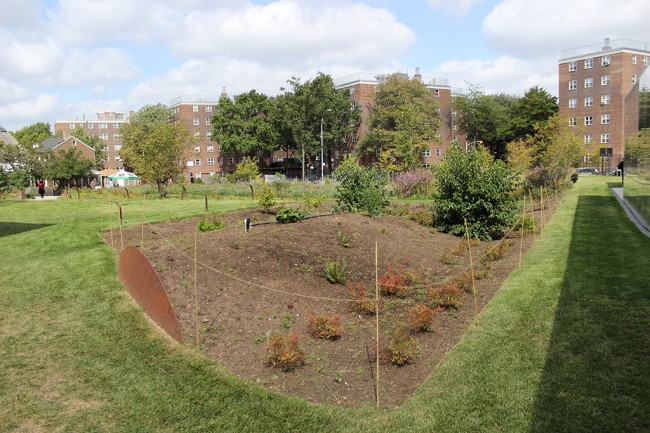
Looking from the new Weeksville Heritage Center building to the Hunterfly Road Historic Houses and Kingsborough Houses along the path of old Hunterfly Road, marked by the steel sheet in the foreground. | Photo by Jonathan Tarleton
But even more crucial to the center’s mission may be its revival as a haven and sanctuary, a community anchor that also happens to be a museum, in a neighborhood where existing residents are increasingly excluded from housing opportunities and familiar businesses shuttered due to rising real estate prices. Rashida Bumbray sees WHC as an especially important resource for youth: “there are so many things that can shift from having an understanding that your life is your own, what is possible, [and] what your ancestors did.” The process of creating Black Radical Brooklyn, according to Eterginoso, has reconnected WHC with other community institutions fighting to preserve the same histories at a time when the changing neighborhood context makes such alliances even more crucial. And Harris hopes to make WHC part of a larger Brooklyn-wide ensemble of organizations that can articulate the ways art and culture can advance conversations on contemporary issues and promote broader understanding and open dialogue. The institution has a state-of-the-art new home befit with a gallery, performance space, classrooms, oral history studio, library, and collection displays in which to realize these ambitions.
The 23,000-square-foot, $34-million building, made possible with public funds from the City’s Department of Cultural Affairs, City Council, Brooklyn Borough President’s office, and private donations, represents a significant commitment in what has traditionally been an area more familiar with disinvestment. “It says to the neighborhood that they are respected, full citizens of the city,” says architect Sara Caples. The design of the building aims to amplify that respect, referencing the area’s past and opening the site to the community. In addition to the building’s deference to the historic houses, Elizabeth Kennedy’s landscape design accentuates the path of the old Hunterfly Road with berms and curved steel panels. The edge of the old farm field rows is followed by a wooden walkway running diagonally to the street grid. The native wildflower meadows and thickets that give the site the bucolic feel of Weeksville’s past open up to the NYCHA Kingsborough Houses just to the north.
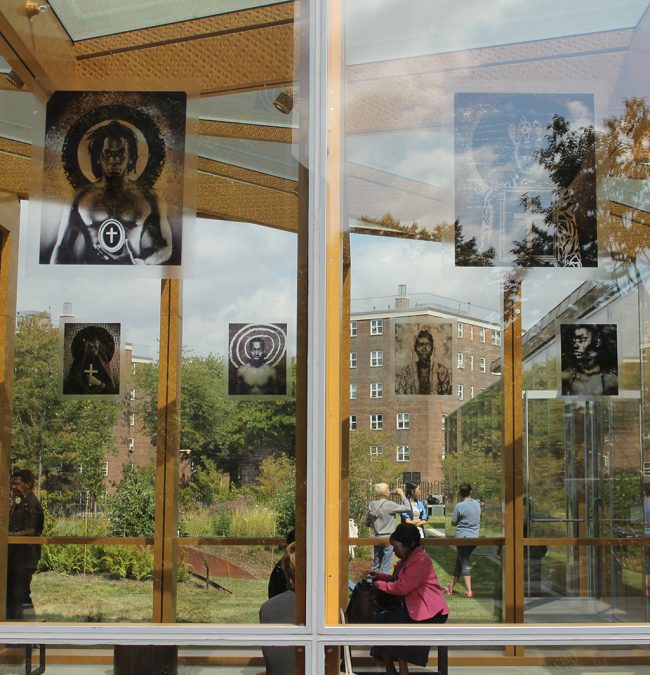
Atrium of new building looking through to the meadow and Kingsborough Houses beyond | Photo by Jonathan Tarleton
But for residents of the neighborhood, contemporary investment in Crown Heights is intimately associated with displacement. To the west of Weeksville, especially along Franklin Avenue, private equity firms have made a practice of buying up apartment buildings with the intention of driving out rent-stabilized tenants, eager to take advantage of the higher rents they can pay to young, often white professionals. And while the visual cues of shifting demographics, chic shops, and rampant renovations have yet to extend to the area around the center, the flyers offering cash for houses have, stoking a fear that this section of Crown Heights will go the way of its eastern neighbors. According to Harris, the center’s five-year construction time frame meant it looked like “just another place that’s popping up in their community that they don’t have access to.” But Harris is committed to shifting this perception by pairing the assets that are local residents and institutions with the resources the new building provides: “I’m ready to fling the gates open and say, ‘Surprise! It’s yours!’” While the designers are worthy of the many prizes they’ve received for the new building and landscape, the true spirit and potential of the building can only be brought out by its occupancy and use.
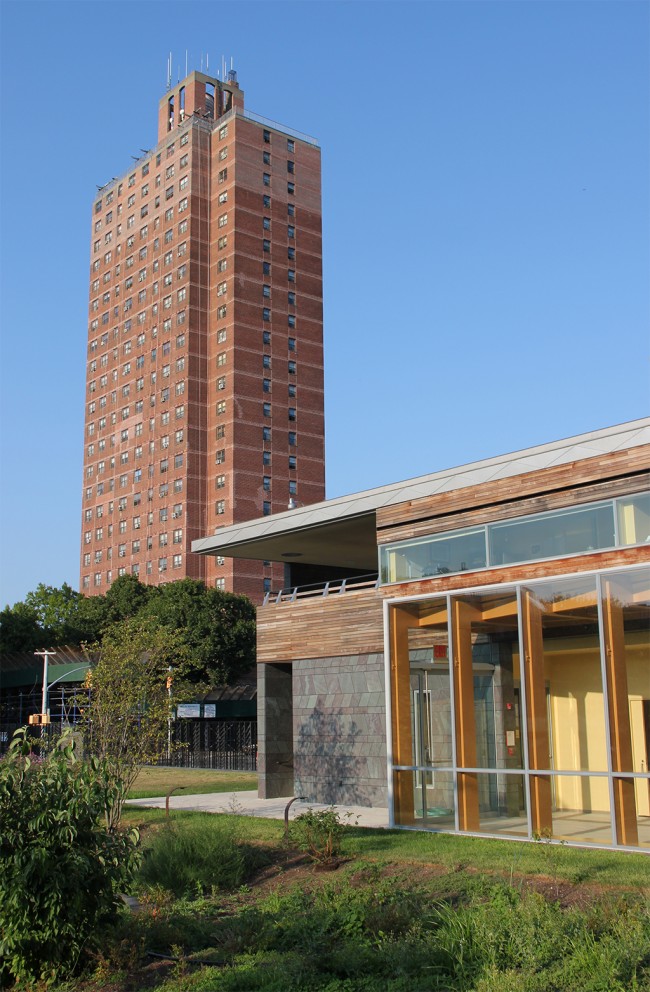
Weeksville Heritage Center’s new building to the right and the Kingsborough Houses senior building rising to the left | Photo by Jonathan Tarleton
The gates are now wide open with Black Radical Brooklyn, and Weeksville’s truly radical history is on display. How reverberations from the installations and wider understanding of the area’s underpinnings will shape the community going forward is unclear. “The legacy of self-determination is still here,” asserts Eterginoso; “It’s been threatened a multitude of times. It’s being threatened right now.” But the hope and pride drawn from learning what your ancestors were able to accomplish can be transformative, says Bumbray.
So far, there is plenty to draw on, from Weeksville’s founding, to its rediscovery and preservation, and now its growing profile and infrastructures. Tia Powell Harris intends to be proactive going forward: “We’ll be controversial,” she says, “like the folks that wanted the right to vote … and bought the land that would eventually give them the opportunity to vote.” After more than 150 years, Weeksville’s struggle for the right to a community continues. And though its residents and institutions are grappling with new pressures, the Weeksville Heritage Center is leveraging its work of preserving a history of self-determination — manifested and sustained in structures, landscape, and ambitious, artistic interpretation — by expanding beyond it, marshaling the past to realize new visions for the neighborhood’s future. The old Hunterfly Road once stretched far beyond it’s renewed imprint among the structures of Weeksville’s historic site; this novel path is another worth extending.
Funk, God, Jazz, and Medicine: Black Radical Brooklyn is on view Fridays, Saturdays, and Sundays from 12–6pm through October 12th. For more information on free classes and talks being held as part of the exhibition, visit Creative Time’s website.
The views expressed here are those of the authors only and do not reflect the position of The Architectural League of New York.